Rossmax Blood Pressure Monitor AV151 Instruction Manual
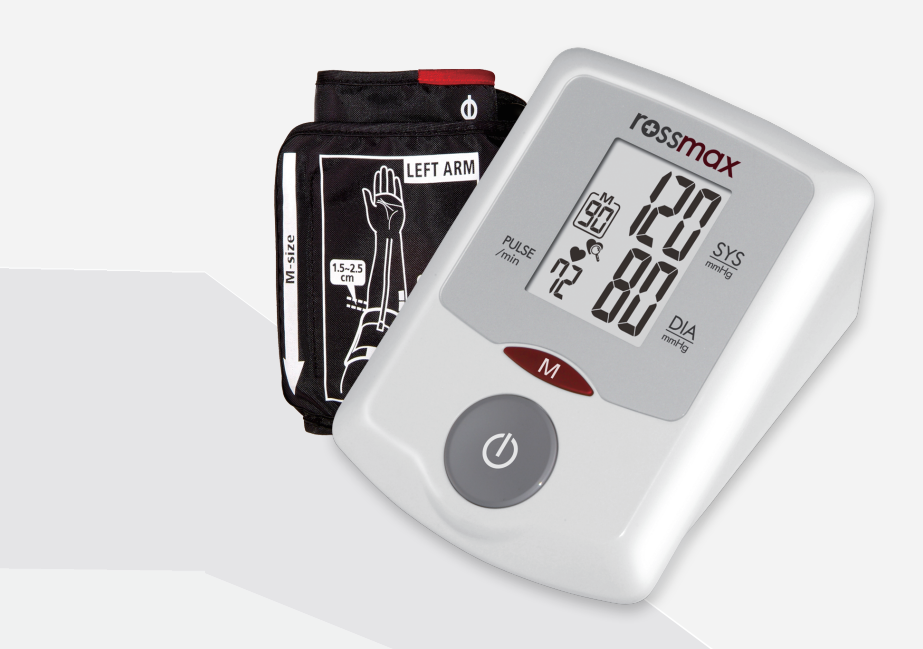
Content
Introducing the Rossmax Blood Pressure Monitor AV151
Blood pressure measurements determined with AV151f are equivalent to those obtained by a trained observer using cuff/stethoscope auscultation method, within the limits prescribed by the American National Standard, Electronic or Automated Sphygmomanometers. This unit is to be used by adult consumers in a home environment. Do not use this device on infants or neonates. AV151. If is protected against manufacturing defects by an established International. The cost of the Rossmax AV151 is approximately $69.99, making it an affordable option for those seeking reliable health monitoring.
Name/Function of Each Part
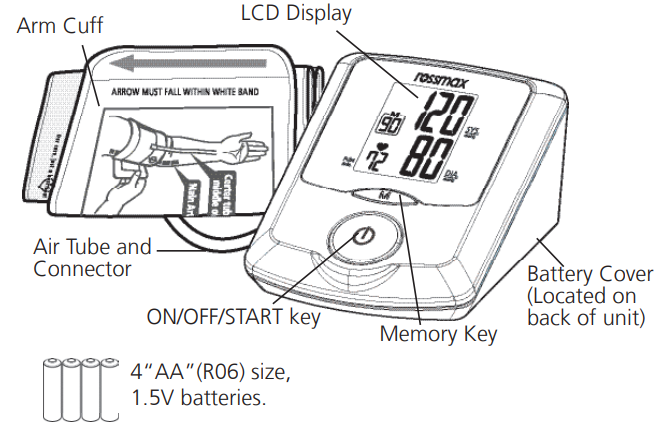
Specifications
Here is the table text as it is from the image:
| Measurement Method | Oscillometric |
|---|---|
| Measurement Range | Pressure: 40~250 mmHg; Pulse: 40~199 beats/ minute |
| Pressure Sensor | Semi conductor |
| Accuracy | Pressure: ± 3mmHg; Pulse: ± 5% of reading |
| Inflation | Pump Driven |
| Deflation | Automatic Air Release Valve |
| Memory capacity | 90 memories |
| Auto-shut-off | 1 minute after last key operation |
| Operation Environment | 10°C~40°C (50°F~104°F); 40%~85% RH |
| Storage Environment | -10°C~60°C (14°F~140°F); 10%~90% RH |
| DC Power Source | DC 6V four R06 (AA) Batteries |
| Dimensions | 145 (L) X 105 (W) X 75 (H) mm |
| Weight | 384.5g (G.W.) (w/o Batteries) |
| Arm circumference | Adult: 24~36 cm (9.4”~14.2”) |
| Limited Users | Adult users |
| Type BF | Device and cuff are designed to provide special protection against electrical shocks. |
| Note | *Specifications are subject to change without notice. |
Real Fuzzy Measuring Technology
This unit uses the oscillometric method to detect your blood pressure. Before the cuff starts inflating, the device will establish a baseline cuff pressure equivalent to the air pressure. This unit will determine the appropriate inflation level based on pressure oscillations, followed by cuff deflation.
During the deflation, the device will detect the amplitude and slope of the pressure oscillations and thereby determine for you the systolic blood pressure, diastolic blood pressure, and pulse.
Preliminary Remarks
This Blood Pressure Monitor complies with the European regulations and bears the CE mark “CE 0366”. The quality of the device has been verified and conforms to the provisions of the EC council directive 93/42/EEC (Medical Device Directive), Annex I essential requirements and applied harmonized standards.
- EN 1060-1: 1995/A1: 2002 Non-invasive sphygmomanometers
Part 1 - General requirements - EN 1060-3: 1997/A2: 2009 Non-invasive sphygmomanometers
Part 3 - Supplementary requirements for electro-mechanical blood pres-sure measuring systems - EN 1060-4: 2004 Non-invasive sphygmomanometers
Part 4: Test Procedures to determine the overall system accuracy of automated non-invasive sphygmomanometers.
This blood pressure monitor was designed for long service time. To ensure accurate measurements, this monitor is recommended to be re-calibrated every two years.
Blood Pressure Standard
The National High Blood Pressure Education Program Coordinating Committee has developed a blood pressure standard, classifying blood pressure ranges into 4 stages. (Ref. The Seventh Report of the Joint National Committee on Prevention, Detection, Evaluation, and Treatment of High Blood Pressure-Complete Report JNC-7, 2004). This blood pressure classification are based on historical data, and may not be directly applicable to any particular patient. It is important that you consult with your physician regularly. Your physician will tell you your normal blood pressure range as well as the point at which you will be considered at risk. For reliable monitoring and reference of blood pressure, keeping long- term records is recommended. Please download the blood pressure log at www.rossmaxhealth.com
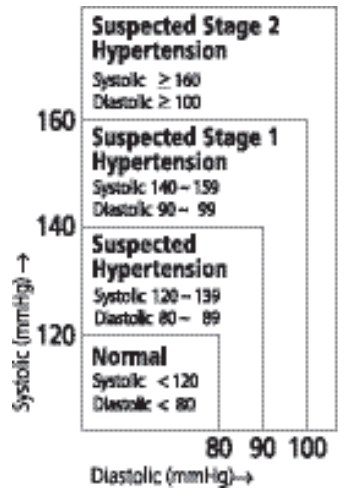
Blood Pressure Fluctuation
Blood pressure fluctuates all the time!
You should not be overly worried if you encounter two or three measurements at high levels. Blood pressure changes over the month and even throughout the day. It is also influenced by season and temperature.
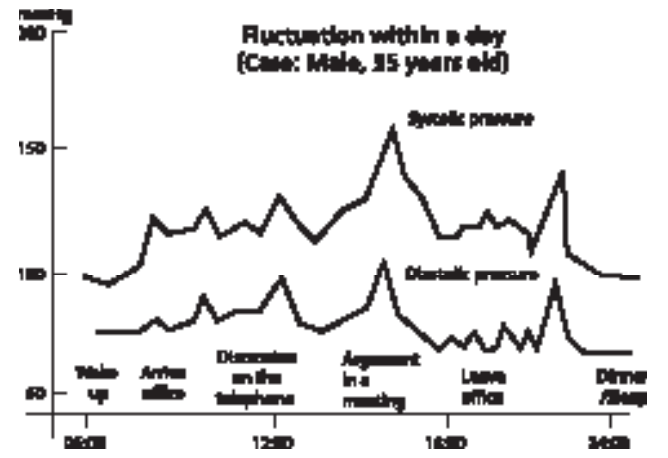
Display Explanations of Rossmax Blood Pressure Monitor AV151

- Memory Mark
- Weak Battery Mark
- Pulse Mark
- Pulse Rate
- Systolic Pressure
- Diastolic Pressure
- Irregular Heartbeat Detector (IHB)
Irregular Heartbeat Detector (IHB)
This unit is equipped with an Irregular Heartbeat Detector (IHB) which allows those who have an irregular heartbeat to obtain accurate measurements alerting the user of the presence of an irregular heart beat during the measurement.
Note: It is strongly recommended that you consult your physician if the IHB icon appears often.
_rossmax_blood_pressure_monitor_av151.png)
Description
The Rossmax Blood Pressure Monitor AV151 is engineered for user convenience. The apparatus is lightweight and compact, facilitating portability. The expansive LCD display guarantees that readings are distinct and easily discernible, especially for individuals with vision problems. The monitor has features such as automated averaging of the latest three measurements and a date/time stamp for each measurement, facilitating users in monitoring their blood pressure over time.
The AV151 features a robust upper arm cuff that is simple to don and adjust, guaranteeing a secure fit for precise measurements. The device operates on four AA batteries, ensuring prolonged usage without the need for frequent replacements. Additionally, it has a travel case for convenient storage and transportation.
Installing Batteries
- Press down and lift the battery cover in the direction of the arrow to open the battery compartment.
- Install or replace 4 “AA” sized batteries in the battery compartment according to the indications inside the compartment.
- Replace the battery cover by clicking in the bottom hooks first, then push in the top end of the battery cover.
- Replace the batteries in pairs. Remove batteries when unit is not in use for extended periods of time.
You need to replace the batteries when- low battery icon
 appears on display.
appears on display. - the ON/OFF/START key is pressed and nothing appears on display.
- low battery icon
Caution
- Batteries are hazardous waste. Do not dispose them together with the household garbage.
- There are no user serviceable parts inside. Batteries or damage from old batteries are not covered by warranty.
- Use exclusively brand batteries. Always replace with new batteries together.
Use batteries of the same brand and same type.
Applying the Cuff
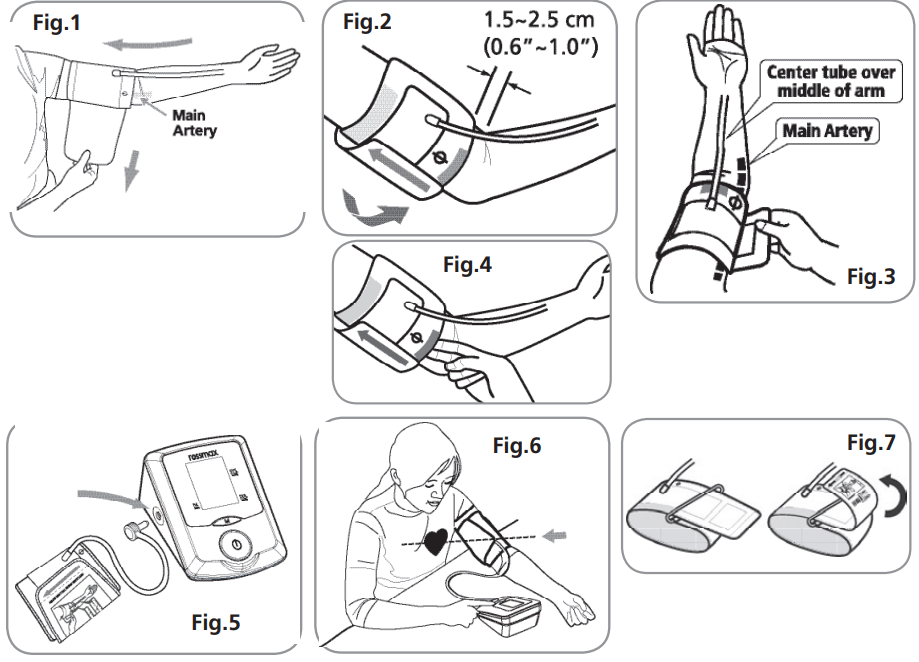
- Unwrap the arm cuff, leaving the end of the cuff through the D- ring of the cuff.
- Put your left arm through the cuff loop. The color strip indication should be positioned closer to you with the tube pointing in the direction of your arm (Fig. 1). Turn your left palm upward and place the edge of the arm cuff at approximately 1.5 to 2.5 cm above the inner side of the elbow joint (Fig. 2). Tighten the cuff by pulling the end of the cuff.
- Center the tube over the middle of the arm. Press the hook and loop material together securely. Allow room for 2 fingers to fit between the cuff and your arm. Position the artery mark (Ø) over the main artery (on the inside of your arm) (Fig. 3,4).
Note: Locate the main artery by pressing with 2 fingers approxi-mately 2 cm above the bend of your elbow on the inside of your left arm. Identify where the pulse can be felt the strongest. This is your main artery. - Plug in the cuff connecting tube into the unit (Fig. 5).
- Lay your arm on a table (palm upward) so the cuff is at the same height as your heart. Make sure the tube is not kinked (Fig. 6).
- This cuff is suitable for your use if the arrow falls within the solid color line as shown on the right (Fig. 7). If the arrow falls outside the solid color line, you will need a cuff with other circumferences. Contact your local dealer for additional size cuffs.
Measurement Procedures
Here are a few helpful tips to help you obtain more accurate readings:
- Blood pressure changes with every heartbeat and is in constant fluctuation throughout the day.
- Blood pressure recording can be affected by the position of the user, his or her physiological condition and other factors. For greatest accuracy, wait one hour after exercising, bathing, eating, drinking beverages with alcohol or caffeine, or smoking to measure blood pressure.
- Before measurement, it’s suggested that you sit quietly for at least 5 minutes as measurement taken during a relaxed state will have greater accuracy. You should not be physically tired or exhausted while taking a measurement.
- Do not take measurements if you are under stress or tension.
- During measurement, do not talk or move your arm or hand muscles.
- Take your blood pressure at normal body temperature. If you are feeling cold or hot, wait a while before taking a measurement.
If the monitor is stored at very low temperature (near freezing), have it placed at a warm location for at least one hour before using it. - Wait 5 minutes before taking the next measurement.
- Press the ON/OFF/START key. All displays will appear for approxi-mately one second before returning to “0”.
- The unit will automatically inflate to the appropriate inflation level based on the user’s pulse oscillations. Measurement will then be-gin. It is important to remain still and quiet during measurement. Any significant movement may affect measurment results.
- When the measurement is completed, systolic, diastolic and pulse will be shown simultaneously and be saved automatically in memory system. Up to 90 memories can be saved.
- Measurement is now completed. Press the ON/OFF/START key to turn off the power. If no key is pressed, the unit will shut off automatically in 1 minute.
This monitor will re-inflate automatically to approximately 220 mmHg if the system detects that your body needs more pressure to measure your blood pressure.
Note: This monitor automatically switches off approximately 1 minute after last key operation.- To interrupt the measurement, simply press the Memory or ON/OFF/START key; the cuff will deflate immediately.
- During the measurement, do not talk or move your arm or hand muscles.
Recalling Values from Memory
- To recall stored blood pressure readings from memory, simply press the Memory key. The last set of memorized readings will be displayed.
- Another press of the Memory key will recall the previous set of readings.
- All readings stored in memory will be displayed with its sequence number.
Setup Guide
- Take it out of the box and check that everything you need is there (monitor, cuff, batteries, etc.).
- Follow the polarity markings on the four AA batteries and insert them into the monitor in the correct order to install the batteries.
- Make sure the cuff fits snugly around your upper arm before adjusting it. When measuring, make sure the cuff is level with the heart.
- To Get the Most Out of Your Device, Hit the Power Button. In order to get your blood pressure reading, the monitor will automatically inflate and deflate the cuff.
- When you look at the results, you'll see your systolic and diastolic blood pressure, as well as any indications of hypertension or irregular heartbeats.
Clearing Values from Memory
Press and hold the Memory key for approximately 5 seconds, then the data in the memory zone can be erased automatically.
Cautionary Notes
- The unit contains high-precision assemblies. Therefore, avoid extreme temperatures, humidity, and direct sunlight. Avoid dropping or strongly shocking the main unit, and protect it from dust.
- Clean the blood pressure monitor body and the cuff carefully with a slightly damp, soft cloth. Do not press. Do not wash the cuff or use chemical cleaner on it. Never use thinner, alcohol or petrol (gasoline) as cleaner.
- Leaky batteries can damage the unit. Remove the batteries when the unit is not used for a long time.
- The unit should not be operated by children so to avoid hazardous situations.
- If the unit is stored near freezing, allow it to acclimate at room temperature before use.
- This unit is not field serviceable. You should not use any tool to open the device nor should you attempt to adjust anything inside the device. If you have any problems, please contact the store or the doctor from whom you purchased this unit or please contact Rossmax International Ltd.
- As a common issue for all blood pressure monitors using the oscillometric measurement function, the device may have difficulty in determining the proper blood pressure for users diagnosed with common arrhythmia (atrial or ventricular premature beats or atrial fibrillation), diabetes, poor circulation of blood, kidney problems, or for users suffered from stroke, or for unconscious users.
- To stop operation at any time, press the ON/OFF/START key, and the air in the cuff will be rapily exhausted.
- Once the inflation reaches 300 mmHg, the unit will start deflating rapidly for safety reasons.
- Please note that this is a home healthcare product only and it is not intended to serve as a substitute for the advice of a physician or medical professional.
- Do not use this device for diagnosis or treatment of any health problem or disease. Measurement results are for reference only. Consult a healthcare professional for interpretation of pressure measurements. Contact your physician if you have or suspect any medical problem. Do not change your medications without the advice of your physician or healthcare professional.
- Electromagnetic interference: The device contains sensitive electronic components. Avoid strong electrical or electromagnetic fields in the direct vicinity of the device (e.g. mobile telephones, microwave ovens). These may lead to temporary impairment of measurement accuracy.
- Dispose of device, batteries, components and accessories according to local regulations.
- This monitor may not meet its performance specification if stored or used outside temperature and humidity ranges specified in Specifications.
Rossmax Blood Pressure Monitor AV151 Troubleshooting
If any abnormality should arise during use, please check the following points.
- EE / Measurement Error: Make sure the L-plug is securely connected to the air socket and measure again. Wrap the cuff correctly and keep arm steady during measurement. If the error keeps occurring, return the device to your local distributor or service center.
- E1 / Air Circuit Abnormality: Make sure the L-Plug is securely connected to the air socket on the side of the unit and measure again. Another possible cause can be due to the short circuit of the microphone embedded in the cuff. If the errors still occur, return the device to your local distributor or service center for help.
- E2 / Pressure Exceeding 300 mmHg: Switch the unit off and measure again. If the error keeps occurring, return the device to your local distributor or service center.
- E3 / Data Error: Remove the batteries, wait for 60 seconds, and reload. If the error keeps occurring, return the device to your local distributor or service center.
- Er / Exceeding Measurement Range: Measure again. If the error keeps occurring, return the device to your local distributor or service center.
- No display when the ON/OFF key is pressed: Re-insert the batteries in the correct positions.
Note: If the unit still does not work, return it to your dealer. Under no circumstance should you disassemble and repair the unit by yourself.
Pros & Cons
Pros
- Accurate Readings: Clinically validated for accuracy.
- User-Friendly Design: Easy to operate with automatic inflation/deflation.
- Advanced Features: Includes IHB detection and hypertension level indicators.
- Affordable: Priced competitively compared to other models in its class.
- Compact design with travel case included.
Cons
- Requires frequent battery replacements if used extensively.
- May not fit very large or very small arms comfortably.
- Does not support wireless data transfer.
Customer Reviews
The Rossmax Blood Pressure Monitor AV151 has received positive feedback from customers about its precision, user-friendliness, and cost-effectiveness. Many customers love the clear display and the straightforward operation, which makes it a good choice for users who are just starting out as well as those who use it frequently. On the other hand, some customers have mentioned that the cuff could not be a comfortable fit for people who have arms that are either larger or smaller.
Complaints that are frequently voiced include the occasional inaccuracy that occurs when the cuff is not positioned correctly and the absence of Bluetooth connectivity for the purpose of data sharing. However, despite these relatively small difficulties, the overall satisfaction rate among users continues to be rather high.
Faqs
What is the cuff size range for the Rossmax?
Is the Rossmax Blood AV151 clinically validated?
How do I know if my Monitor AV151 is working correctly?
Can I use the Rossmax Blood Pressure if I have a pacemaker?
What are some common issues with the Monitor?
How many readings can the Rossmax Blood store?
Is the Rossmax Blood easy to operate?
Does the Rossmax come with a travel case?
What are some advanced features of the Blood Pressure Monitor?
How long does the battery life last on the Rossmax?
Leave a Comment
